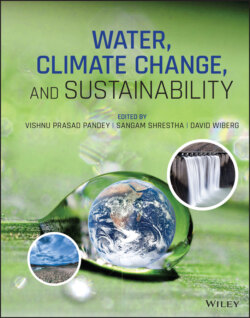Читать книгу Water, Climate Change, and Sustainability - Группа авторов - Страница 42
3.2.4. Existing and Emerging Methods for Water Conservation
ОглавлениеFeedstock production consumes the largest amount of freshwater in bio‐based systems, and hence efforts should be concentrated on minimizing water use in agricultural production systems. Water‐efficient and targeted irrigation systems are possible solutions to minimizing freshwater use in feedstock production (Levidow et al., 2014). Recent advancements in irrigation technologies provide various water saving irrigation options to the farmers over the conventional irrigation methods. Water application efficiency of a conventional furrow irrigation system is around 35–60%, while sprinkle and drip irrigation systems have higher application efficiencies of 60–70% and 80–98%, respectively (Evans, 2019). These techniques minimize water losses through evaporation, surface run‐off and percolation; and hence, they maximize the water application efficiency. In addition, irrigation management practices should be directed to maximization of water use efficiency through proper irrigation timing, supply of appropriate amount of water, and minimization of water losses through evaporation and percolation. For example, corn requires the largest amount of water during the tasseling, silking, and dent forming stages compared to the other stages (Kranz et al., 2008). Therefore, it is important to recognize the required quantity of water during different stages of the crop growth, to maximize the water use efficiency.
Natural solutions for water conservation are also effective; they include wetland creation and rainwater harvesting in the wetlands, which supply water for irrigation during the dry season. Genetic modification of crops toward development of more drought tolerant varieties also helps water conservation. Application of compost and mulch, planting cover crops, and using conservation tillage practices are other pathways to reduce the water use in agriculture production phase. They improve the water retention quality of the soil and reduce the evaporation during the plant growth (Texas Water Development Board, 2019).
Water use efficiency can be improved in bio‐based industries by using water recycling and reuse systems. For example, dilution of the feedstock, cooling, and steam generation were found to be the most water intensive processes in a distillery in India (Saha et al., 2005). Water savings were achieved by using treated wastewater instead of freshwater to replace the cooling water evaporation losses (Saha et al., 2005). Total water use for corn ethanol production in the US is 45 billion gallons per year. Water use in ethanol production industries in the US is minimized by recycling the cooling water rather than discharging it, using reclaimed water from the wastewater treatment plants, and using reverse osmosis to reuse the wastewater from the ethanol plants (Jessen, 2012).
